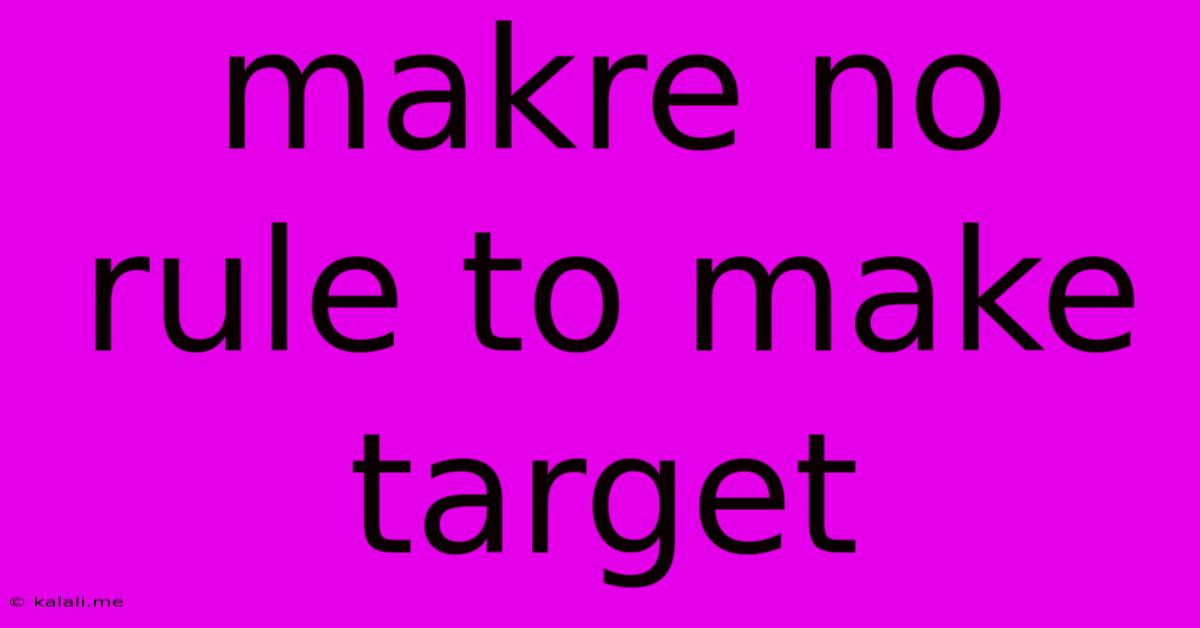Makre No Rule To Make Target
Kalali
May 25, 2025 · 3 min read

Table of Contents
Making Targets Without the Rules: A Flexible Approach to Goal Setting
Setting targets is crucial for personal and professional growth, but rigid rules often stifle creativity and adaptability. This article explores a more flexible approach to goal setting, focusing on achieving targets without the constraints of strict rules. We'll discuss the benefits of this method and provide practical strategies for implementation.
Why Ditch the Rigid Rules?
Traditional goal setting often involves strict rules: specific, measurable, achievable, relevant, and time-bound (SMART) goals. While SMART goals offer structure, they can be overly restrictive. Life is unpredictable, and rigidly adhering to a plan can lead to frustration when unexpected obstacles arise. A more fluid approach allows for adjustments based on changing circumstances and new opportunities.
The Advantages of a Flexible Target System:
- Increased Adaptability: Life throws curveballs. A flexible system allows you to pivot and adjust your targets as needed, maximizing your chances of success.
- Enhanced Motivation: Rigid rules can feel limiting and demotivating. A more flexible approach fosters a sense of autonomy and control, boosting motivation.
- Greater Creativity: Without the constraints of strict rules, you can explore more creative solutions and approaches to achieve your targets.
- Reduced Stress: The pressure of adhering to rigid deadlines and metrics can be stressful. A flexible system reduces this pressure, promoting a more positive and sustainable approach.
- Improved Resilience: When setbacks occur, a flexible system allows you to regroup and readjust your strategy without feeling like you've failed completely.
Strategies for Flexible Target Setting:
- Focus on Outcomes, Not Processes: Instead of outlining precise steps, focus on the desired outcome. This allows for greater flexibility in how you achieve your goals.
- Embrace Experimentation: Try different approaches and strategies. Don't be afraid to deviate from your initial plan if something isn't working.
- Regular Review and Adjustment: Regularly review your progress and adjust your targets as needed. This ensures your goals remain relevant and achievable.
- Set Guiding Principles: Instead of rigid rules, establish guiding principles that will inform your actions. These principles should be flexible enough to adapt to changing circumstances.
- Prioritize Flexibility: Build in buffer time and contingency plans to accommodate unexpected events. This helps prevent setbacks from derailing your progress.
- Celebrate Milestones: Acknowledge and celebrate progress along the way, even small achievements. This keeps you motivated and engaged in the process.
Example: Instead of: "Write 1 blog post per week for 3 months," try: "Increase my blog's content by 12 posts in the next 3 months." The second goal allows for flexibility in posting frequency while still achieving the desired outcome.
Conclusion:
While structure is important, rigid rules can hinder progress. By adopting a flexible approach to target setting, you can increase your adaptability, motivation, and overall chances of success. Remember to focus on outcomes, experiment freely, and regularly review and adjust your strategy to navigate the unpredictable journey towards achieving your goals. This flexible system empowers you to reach your targets while embracing the unexpected twists and turns of life.
Latest Posts
Latest Posts
-
How To Keep Groundhogs Out Of Garden
May 26, 2025
-
Oil Based Vs Water Based Poly
May 26, 2025
-
How To Take A Small Dent Out Of A Car
May 26, 2025
-
Dogs Begin To Smell Her Lyrics
May 26, 2025
-
Was Daniel Of The Bible A Eunuch
May 26, 2025
Related Post
Thank you for visiting our website which covers about Makre No Rule To Make Target . We hope the information provided has been useful to you. Feel free to contact us if you have any questions or need further assistance. See you next time and don't miss to bookmark.